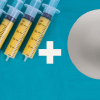Dissolving your facial filler in Sydney
With pillow faces everywhere, and some people now (thankfully) starting to realise that they have overdone their fill, many are turning to filler dissolution as an option to address this problem.
Requests for dissolving filler are becoming increasingly common in Dr Simone’s practice. Thankfully filler in many cases can be removed with targeted injections. Read below on what is involved.
What is the main reason filler dissolution is performed?
Chronic lumps from injections
Distorted appearance or anatomy eg puffy eyelids or overdone lips
Wanting to start over in a more subtle manner
Complications-blood vessel occlusion or an inflammatory lump called a granuloma -every practice should have a filler emergency kit to deal with these
Can all fillers be dissolved?
Most hyaluronic acid fillers will respond to some extent to dissolution. However, it does depend on how long the product has been there, which exact formulation of hyaluronic acid has been used.
No other fillers such as permanent or semi-permanent fillers can be dissolved. Whilst there are now fat dissolution agents designed for use in the neck, their use in fat dissolving has not been tested.
Filler can be dissolved with an enzyme called hyaluronidase.
What is hyaluronidase, the filler dissolution agent?
Hyaluronidase is present in our bodies and is what breaks down fillers over time. It also degrades other mucopolysaccharides present in the skin such as glycosaminoglycans in the skin’s extracellular matrix. It does not affect collagen or the cells that synthesise it (fibroblasts).
The synthetic version of this is injected for filler dissolution.
It is used in medicine to increase dispersion of local anaesthetic through tissues.
Its use as a filler dissolution agent is “off label” and not designed for this.
How much hyaluronidase is needed and how long does dissolution take?
Like many things in the cosmetic filler world, there is not a lot of scientific data on exactly how particularly fillers will behave and no consensus on the exact dose needed to dissolve them.
Many fillers will even respond after a few years being present. If the dissolution agent is successful, generally the dissolution can be seen and felt almost immediately, with the agent continuing to work for several hours afterwards.
The more cross-linked a product, the more it is likely to resist being broken down by hyaluronidase. is, the longer it can last in the body and the more it will resist breakdown by both native and injected hyaluronidase. Therefore more cross linked or thicker fillers can be more difficult to dissolve than thinner ones. However, thinner fillers can be prone to more complications such as migration. Sometimes a second session of dissolution can help.
Can MRI help in identifying filler problems?
MRI can help show where residual filler remains, however problems can usually be felt and seen on the surface.
It is a helpful research tool and has reinforced the fact that fillers can last much longer than initially thought.
See some MRI studies here of residual facial filler here.
Does hyaluronidase attack the body’s own tissues?
There are reports of feeling like the area is excessively sunken or hollow afer filler dissolution. This is more likely to be from the effects of the filler disappearing rather than any lasting effect on the body’s own hyaluronic acid.
The body does replenish hyaluronic acid, however, as we age, it does decline in its production .No study has proven that it does have a permanent effects of the body’s own tissue.
What are potential other side effects of hyaluronidase?
People allergic to bee or insect bites (which contain some hyaluronidase) are at increased risk of an allergic reaction to hyaluronidase. These are thankfully rare. A skin patch test for people with this history is advisable.
It can cause prolonged swelling for a few weeks in some people post-injection.
What can be done to the area after filler dissolution?
A dissolved area area of filler can be filled with new filler or fat.
Or it can be left alone!
Or if it was the wrong antiageing tool, try a a better one!
If you want your filler dissolved by Dr Simone Plastic Surgeon in Sydney, you can make an appointment first online.





